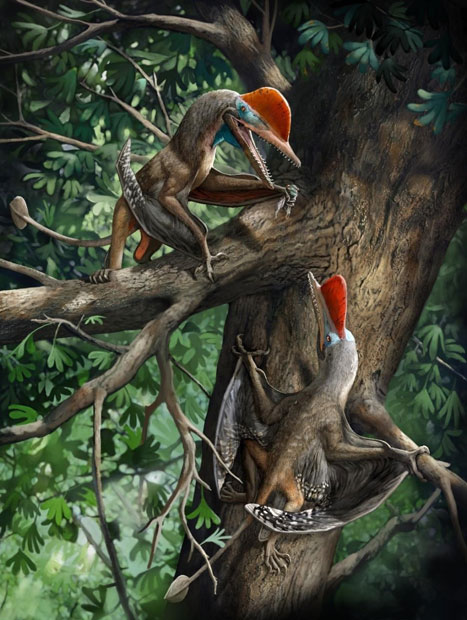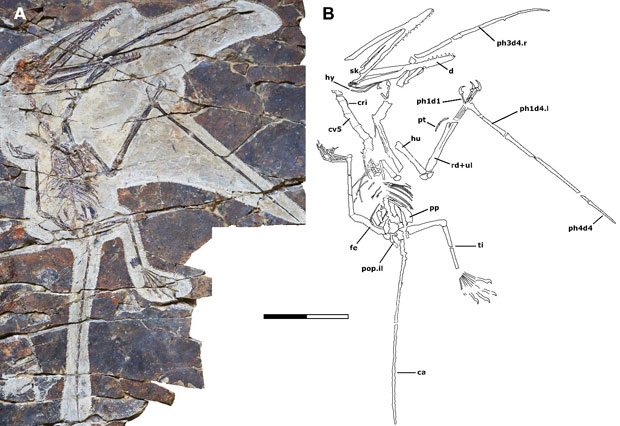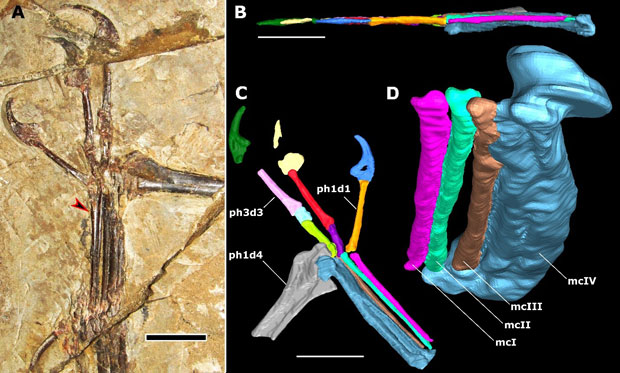An opposable thumb gives us apes a huge advantage, just ask a dog to hold a spoon for you, however, opposable thumbs are not just limited to gorillas, chimps, orangutans and our own genus Homo. Other apes have them too, as do some marsupials and tree frogs. In reality, opposed thumbs are rare in the Kingdom Animalia, but an international team of scientists including researchers from the University of Birmingham, have just described a new species of flying reptile and it’s the earliest example known to science of a vertebrate with an opposed thumb.

Kunpengopterus antipollicatus
The new Jurassic pterosaur has been named Kunpengopterus antipollicatus, it was discovered in the Tiaojishan Formation of Liaoning, China.
It is a small-bodied darwinopteran pterosaur, with an estimated wingspan of 85 cm. Most importantly, the specimen was preserved with an opposed pollex (“thumb”) on both hands. The species name “antipollicatus” means “opposite thumbed” in ancient Greek, in light of the opposed thumb of the new species. This is the first discovery of a pterosaur with an opposed thumb. It also represents the earliest record of a true opposed thumb in the fossil record.

“Monkeydactyl”
Kunpengopterus lived in a forested environment approximately 160 million years ago. It was nicknamed “monkeydactyl” as a true opposed thumb (pollex) is extremely rare amongst extant reptiles, only chameleons possess opposed thumbs. They use their thumbs to help them climb, the researchers writing in the academic publication “Current Biology”, also suggest that Kunpengopterus evolved such dexterity to help it to climb.
In order to test the arboreal interpretation, the team analysed K. antipollicatus and other pterosaurs using a set of anatomical characters related to arboreal adaptation. The results support K. antipollicatus as an arboreal species, but not the other pterosaurs from the same ecosystem. This suggests niche-partitioning among these pterosaurs and provides the first quantitative evidence supporting the theory that at least some darwinopteran pterosaurs were arboreal.
Minimising Competition Amongst Pterosaurs
Lead author Xuanyu Zhou (China University of Geosciences) commented:
“Tiaojishan palaeoforest is home to many organisms, including three genera of darwinopteran pterosaurs. Our results show that K. antipollicatus has occupied a different niche from Darwinopterus and Wukongopterus, which has likely minimised competition among these pterosaurs.”

Micro-CT Imaging Assists in Discovery
Fion Waisum Ma, co-author of the study and PhD researcher (University of Birmingham) explained:
“The fingers of “Monkeydactyl” are tiny and partly embedded in the slab. Thanks to micro-CT scanning, we could see through the rocks, create digital models and tell how the opposed thumb articulates with the other finger bones. This is an interesting discovery. It provides the earliest evidence of a true opposed thumb, and it is from a pterosaur – which wasn’t known for having an opposed thumb”.
Everything Dinosaur acknowledges the assistance of a press release from the University of Birmingham in the compilation of this article.
The scientific paper: “A new darwinopteran pterosaur reveals arborealism and an opposed thumb” by Xuanyu Zhou, Rodrigo V. Pêgas, Waisum Ma, Xuefang Wei, Caizhi Shen and Shu’an Ji published in Current Biology.






Pandas also have opposable thumbs, but don’t seem to use them for much.